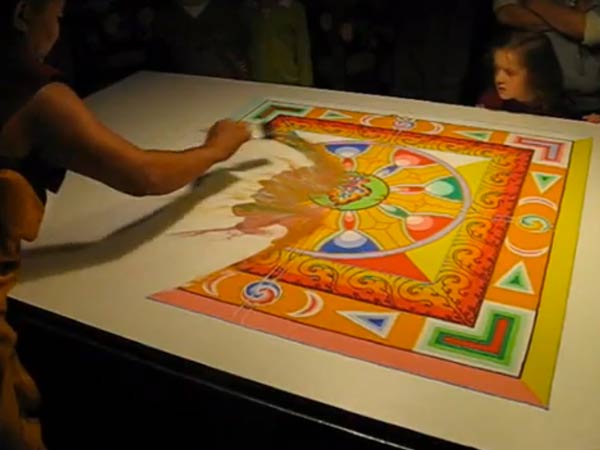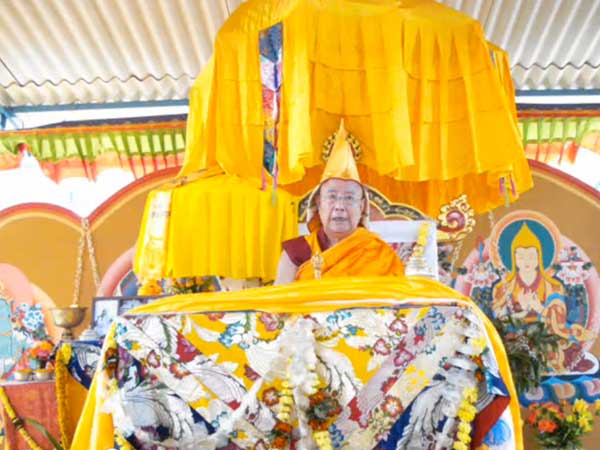DHARMA READINGS
| TEACHINGS ON JE TSONGKHAPA'S THREE PRINCIPAL ASPECTS OF THE PATH - QUESTIONS AND ANSWERS | | Print | |
|
Page 5 of 5
 Questions and Answers Q: Would Your Holiness clarify whether the determination to achieve liberation is not linked at all with the conception of true existence or the conception of phenomena as inherently existent? However, in the case of ordinary beings like us, who do not have a correct or authentic understanding of liberations mode of existence, but merely a wish to attain it, while no doubt the wish is genuine, due to not understanding the real nature of phenomena, we might see liberation itself as truly or inherently existent. In other words, not having a good understanding of phenomenas lack of inherent existence, the wish to attain liberation is polluted by the conception of true existence. In a verse of sutra the Buddha says that if on seeing the illusory image of a beautiful woman you feel a desire for her, it is foolish to regret it later when you realize that she was only an illusion, because there was no woman there in the first place. Similarly, if you think of liberation as truly existent, although it is not, then it is true to say that your aspiration towards liberation is not authentic.
Q: Can we use a term like the bliss of liberation? But if you are asking this question from the point of view of whether liberation itself is bliss, then it is not, because it is an impersonal phenomenon. Actually, liberation or cessation is a quality, a complete cessation of delusion within the particular person who has attained and actualized liberation. With reference to that person and when he or she attains liberation, it is the person himself or herself who experiences bliss. So, if you ask whether the person experiences the bliss of liberation, the answer is yes, but if you ask whether liberation itself is bliss, then the answer is negative.
Q: How is meditation related to getting rid of the suffering of sentient beings?
Q: How is one's aspiration towards liberation related to the experience of suffering?
Q: When the Hearers and the Solitary Buddhas have destroyed delusions completely and become Foe Destroyers, do they possess a neutral mind?
Q: People who have not realized emptiness see all phenomena as existing inherently and because of that they generate anger, attachment and so forth. But how do those people who have realized emptiness generate anger and attachment since the realization of emptiness is a direct antidote to the experience of the conception of true existence? Even after you have gained direct realization of emptiness there are higher paths such as the path of seeing and path of meditation. Intellectually acquired delusions are those that are eliminated by the path of seeing and are thus eliminated when one sees emptiness directly. They come about as a result of studying mistaken philosophical ideas. In other words they are products of wrong view. When you see emptiness or ultimate reality directly, naturally intellectually acquired delusions, products of wrong view are automatically eliminated. Therefore, you have to become thoroughly familiar with this realization of the true nature of phenomena. Then gradually as you attain the path of meditation, you will be able to eliminate the very root cause of delusions. Now, how is this conception of true existence, or the conception that things exist inherently, responsible for generating delusions like anger, attachment and so forth. Normally speaking it is not necessarily the case that wherever there is a conception of true existence delusions like attachment and anger are generated because there are occasions when you have only a conception of true existence. But wherever there is attachment or anger it follows that it is due to a conception of the true existence of phenomena. When you generate attachment, you not only see the object as something interesting or attractive, but you see it as something totally attractive, totally interesting, and existing inherently from its own side. Because of that kind of misconception of phenomena, you generate strong attachment. Similarly, when you see something as uninteresting or unattractive, you do not see it just like that, you see it as totally uninteresting and unattractive, you do not see it just like that, you see it as phenomena. The principal cause of all these different delusions, like attachment and anger, is the conception of I and mine. First you generate attachment towards the I and because of this you start to generate all kinds of other delusions. Usually, you actually do not think about what this I is, but when it arises automatically, you have a strong sense of an I, which is not just nominally existent, but a solid I existing inherently from its own side. Recognizing the existence of a conventional I is all right, but when you exaggerate it as having an independent existence it is wrong. That is the wrong view of transitory collection. Because you have that kind of conception of the Is true existence, you generate other delusions like the conception of mine thinking, This or that is mine. When you have this conception of things as mine you divide everything into two classes: those that you like, which you think of as mine, as interesting, as my friend and so on, based on which you generate a lot of attachment: and those that do not belong to you or that have harmed you or are likely to harm you, you classify into a different category and neglect them. Because of your conception of the I and the feeling that you are somehow supreme, someone very important, you become proud. Due to this pride, when you dont know something you generate deluded doubt and when you encounter a challenge from people who have qualities or wealth similar to your own, you generate the delusions of jealously and competitiveness towards them.
Q: What is the meaning of a definite action and an indefinite action? On the other hand, if you have not generated the intention to commit a particular action, then even if you have done something, the result will not be definite. So, it is called an indefinite action. In general, there are many kinds of actions explained in Asangas Compendium of Manifest Knowledge (Abhidharma Samuccaya): actions that are committed and not accumulated, actions that are accumulated and not committed and actions that are both committed and accumulated. Actions that are accumulated and not committed are definite actions. Actions that are committed and not accumulated are indefinite actions because, for example, of not being motivated. Now, to explain this point more clearly, let us take the example of killing an animal. Generally speaking killing leads to bad rebirth. But if you kill a particular animal without intending to kill it, for instance if you unknowingly trample on an insect and kill it, but then realizing what you have done you generate a strong sense of regret, the result will be indefinite. Because you have actually killed the insect you have committed the action of killing, but you have not accumulated the action because you did not intend to kill it. In this case the result is not definite, which means that this act of killing will not lead to the normal result, bad rebirth, because of the absence of intention and having subsequently felt regret. However, since the act of killing was committed it will bear its own fruit. It does not lead to profit.
Q: How is it possible, especially for a person who comes from the West to generate a sense of renunciation, an unwillingness to enjoy the pleasures of the world in which we are living? We can also classify suffering into three levels: the suffering of suffering; the suffering of change and pervasive compositional suffering. This last one, pervasive compositional suffering, refers to the fact that our physical body, projected by contaminated actions and delusions, itself acts as the basis for experiencing all the different levels of suffering. It is important to know the various levels and stages of suffering and how to do meditation. In general, if you have no anxiety, no troubles and no worries, that is best. We think of practicing the Buddhas doctrine because we have some suffering, some anxiety, but if you dont have these then there is no need to practice; just enjoy yourself.
Q: Since we have this conception of a truly existent self, is it possible to benefit other beings? Translated by Lobsang Jordhen & edited by Jeremy Russell
|
OTHER DHARMA READINGS
- A GUIDE TO SPIRITUAL PRACTICE
- DHARMA DEMYSTIFIED: NAGARJUNA, THE FOUNDER OF THE MAHAYANA TRADITION
- DORJE SHUGDEN ON BLACK HORSE
- WHY MANJUSHRI MATTERS
- DHARMA DEMYSTIFIED: THE ENTHRONEMENT OF DORJE SHUGDEN









